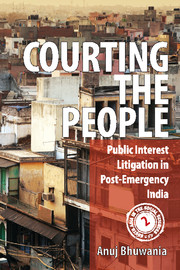Book contents
- Frontmatter
- Contents
- Acknowledgements
- Introduction
- 1 Competing Populisms: Revisiting the Origins of Public Interest Litigation in India
- 2 The Case that Felled a City: A PIL with Nine Lives
- 3 Public Interest Litigation as a Slum Demolition Machine
- 4 Good Judges, Bad Judges: Critical Discourses on Public Interest Litigation in India
- Conclusion: The Procedural is Political
- Bibliography
- Index
3 - Public Interest Litigation as a Slum Demolition Machine
Published online by Cambridge University Press: 23 July 2017
- Frontmatter
- Contents
- Acknowledgements
- Introduction
- 1 Competing Populisms: Revisiting the Origins of Public Interest Litigation in India
- 2 The Case that Felled a City: A PIL with Nine Lives
- 3 Public Interest Litigation as a Slum Demolition Machine
- 4 Good Judges, Bad Judges: Critical Discourses on Public Interest Litigation in India
- Conclusion: The Procedural is Political
- Bibliography
- Index
Summary
Yeh High Court is sheher par raaj karti thi. (This High Court used to rule this city.)
–Delhi High Court correspondent for the Hindustan TimesIn the first decade of the twenty-first century, the Delhi High Court presided over the most comprehensive and ruthless campaign to remove informal ‘slum’ settlements that the city had seen in a generation. According to the official statistics, in 1998, Delhi had about 3 million people living in 1,100 Jhuggi- Jhompri clusters. When the next such survey was conducted in March 2011, the official figure had fallen to 685 jhuggi-jhompri clusters housing around 2 million people.The only other period when there was such a massive recorded fall in the slum population in Delhi was between 1973 and 1977, when it fell from about half a million to about a hundred thousand, with a decline of about 80,000 slum households. This decline in 1973–77 is infamous because this was the period in which the Internal Emergency was in force (between 1975 and 1977) and one of the most notorious ‘achievements’ of the Emergency was a massive programme of forced relocation of slums – a well-known aspect of Delhi's contemporary history. But how did this other more recent decline in the slum population of Delhi take place? If the Emergency regime saw a breakdown of political negotiations as a technocratic elite ran amok, the period between 1998 and 2011 saw a very similar process unfold – only this time the vehicle was Delhi's appellate judiciary, particularly the Delhi High Court, acting principally in its Public Interest Litigation (PIL) jurisdiction. In this chapter, I will examine how the procedural departures made possible by India's peculiar PIL jurisdiction enabled it to function as a slum demolition machine.
This phenomenon of the court-led slum demolition drive in Delhi has recently been analyzed and explained by some scholars. However, the difficulty with the existing literature on this topic is that it treats PIL cases as if they are like any to be so uniquely well-suited to facilitate such an expansive and unconventional judicial role. The still common emphasis on the dilution of locus standi of the petitioner as the only significant attribute of a PIL case represses the other radical characteristics of such cases that in reality take it far beyond any understanding of an adjudicative proceeding.
- Type
- Chapter
- Information
- Courting the PeoplePublic Interest Litigation in Post-Emergency India, pp. 80 - 111Publisher: Cambridge University PressPrint publication year: 2016



